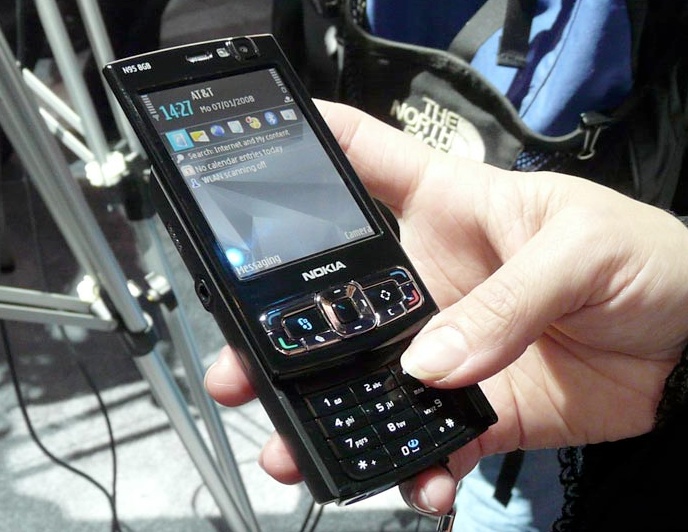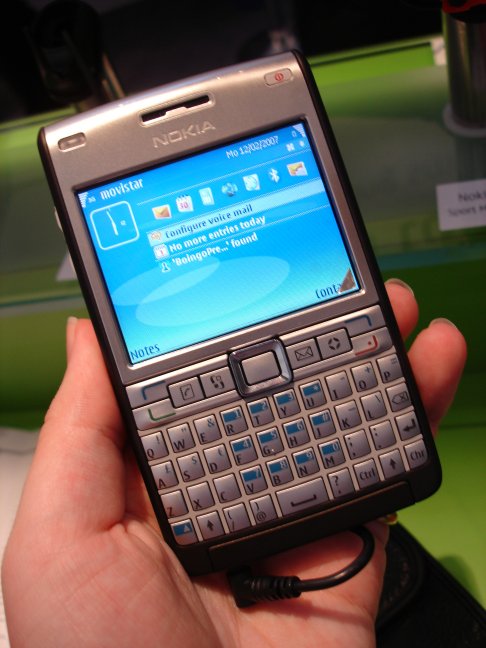1. Nokia N95 8GB
It all started when I caught several non-techy tradesmen using the black monster, the Nokia N95 8GB, as their main phone. In each case, they'd tried a touchscreen phone (respectively a LG Cookie and an iPhone) and in each case had returned to 'their old Nokia' because it was foolproof and wasn't fiddly to use while working.
But this isn't a touchscreen rant - what caught my eye for the umpteenth time was the huge 2.8" display, to this day unusual for a non-touch device. Appearing on the N95 8GB and N96, this large, clear, transflective display was stunning for its time and, for information display, still streets ahead of most of the pack. What's happened to this form factor? The newer N86 has only a 2.6" screen, noticeably smaller, and there are a plethora of 2.4" and 2.2" screened sliders also available.
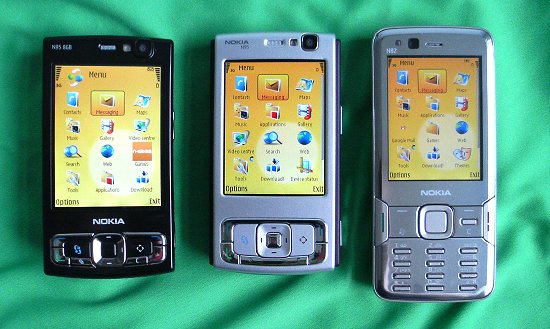 Comparison, 2.8" display (N95 8GB), 2.6" (N95), 2.4" (N82)
Comparison, 2.8" display (N95 8GB), 2.6" (N95), 2.4" (N82)
It's been tempting to go back to the form factor myself - the N96 is the most up to date, but it's so plasticky and slow, with no graphics acceleration. So I find myself about to bid on N95 8GB units on eBay and then have to stop myself, remembering that quite a lot of the software we take for granted these days, including up to date Ovi Maps with free navigation, is either not available or requires extra downloads or payment or hassle. Plus there was the non-expandable 8GB of flash memory. Gah.
What's needed, Nokia, is an update of the N95 form factor. Use the N96's 2.8" transflective screen, use the N86's keypad (or perhaps a slide down E71-style minature qwerty?), put in the very latest builds of Ovi Maps, and Ovi Store, on the latest version of S60 3rd Edition FP2, as used in the likes of the N86 or E72, put in the N86's camera (there's plenty of room) and - hey, let's shoot for the moon - a Xenon flash. Call it the N87, perhaps? I would buy the result in an instant.
2. Nokia E61i
Now - the 2.8" transflective display wasn't only used in the two Nseries smartphones. Oh no. It was also the highlight of the qwerty-based Nokia E61 and E61i - we'll skip over the former as it was very much a first-gen attempt at the form factor - and had, among other big downsides, no camera.
The E61i was almost decent though, with microSD expansion, the huge BP-4L battery and a 2 megapixel camera, just held back by being the last Nokia to use the dreaded Pop-port rather than a form of USB, and by a rather weedy processor and RAM quotient, which meant that using the E61i required a healthy degree of patience. Most importantly of all, there was the 2.8" display and, mounted in landscape mode, this enforced a certain width to the device - which meant that bigger keys could be fitted. Where the modern E71, E72 and E5 all require pretty small and nimble thumbs, the E61i could be used with comparative ease, however much text you needed to bash out in an email or text.
So what happened? I guess someone at Nokia's design bureau made a strategic decision that the E61i form factor was too big - which is strange since some of the RIM Blackberrys of the time had similar width, screens and keyboards. So the E71 was borne - with a 2.4" display and a shrunk-down keyboard. And, even curiouser, RIM then followed suit with a downscaling of their flagship Bold series to use smaller screens and smaller keyboards. Did the human race suddenly just evolve smaller thumbs?
So here's to the Nokia E67, with the E61i form factor (screen/keyboard), but with the latest S60 3rd Edition FP2 (as above), a 5 megapixel autofocus camera, dual LED flash, microUSB data and charging, full 32GB card support (the E61i was limited to 2GB, sadly) and a processor bump.
Definitely a form factor which deserves another airing. Nokia could even use the same case!
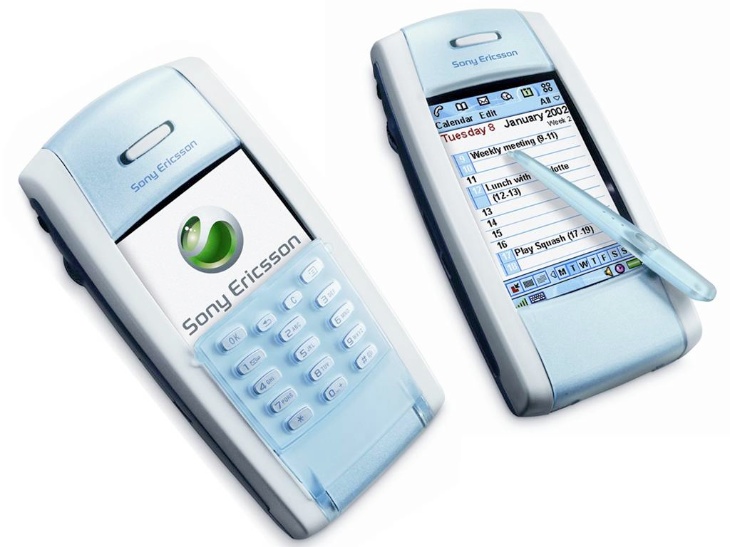
3. Sony Ericsson P800
Yep, that's right, I said P800, not P900. The latter is the one everyone remembers as the classic UIQ device, the original touchscreen interface on top of Symbian OS, but that's because it looked more modern, had slightly better performance and the advantage of another year of software development. The P800 was the really innovative one, a pure touchscreen device, a la 2010, with a really clever passive flip keypad in which the keys 'prodded' through to press the appropriate points on the touchscreen beneath.
By using this passive system, no fragile wiring was needed through to the keypad and the mechanism to attach it could be kept simple. In practice it was the work of only a minute to detach (or attach) the keypad and transform the phone from standard form to touchscreen slate. Terrific stuff, and there was the added benefit of a transflective screen, so it worked in the sun, unlike the P900, for which Sony Ericsson had decided, in their infinite wisdom, to equip it with a 'modern' TFT that looked a bit better indoors but was invisible outdoors. Sigh.
(Real Symbian 'nuts' may, at this point, also bring up the Ericsson R380i, using a similar passive flip to the P800 and its direct ancestor - but which had a non-extensible very early version of Symbian, making it not - technically - a smartphone)
I would say that, with so many people getting a little bored of vanilla touchscreen tablets, what better time to bring back the P800 transformer form factor? Clip on a hinged keypad and get the best of both worlds. But there's a slight problem, in that the 'prod through' system for the keys relied on a traditional resistive touchscreen beneath. Maybe a modern version would have conductive keys and protrusions so that keypresses would still 'work' on a modern glass capacitive touchscreen? A challenge for a manufacturer!

4. Nokia N93
Who can forget the N93, the original transformer phone and one which could be clamshell, laptop or camcorder, depending on how you twisted its screen and double-hinge? Owing a debt to the N90, which very much paved the way, the real kicker for me was the way the camera features/application started automatically when you opened and twisted the N93, in order to start taking photos or videos. In other words, an intuitive physical motion got you to right place in the software and left you with a very obvious camera/camcorder configuration.
When someone points an opened N93 at you, it's immediately obvious what they're doing, it even looks like a 'real' camcorder, and there's a resulting unspoken communication about you knowing what you're doing and taking quality footage. Whereas with a modern phone - even the N8 - it's accepted that you're trying to take photos or video, but the subject's expectations aren't that high (they've seen what the average phone produces for photos or video).
So... what about the N93's form factor revived, but with that huge camera barrel containing the N8's large 12mp sensor and with 720p? Or even Nokia's first device with 'real' 1080p HD video capture? Wouldn't that be a great reason to bring back the transformer? Inside, as with several of the devices above, it would probably run a variant on the N86's current firmware, but with all the modern gadgets that 2010 brings (the camera specs above, plus GPS/navigation/FM transmitter/HDMI out and so on, a future N99 would certainly get a lot of camera phone fans very excited.
PS. Nokia did do an N93i, with sleeker looks and with planned enhancements like continuous auto-focus, something which we're still struggling to get right in 2010, but the N93i flopped because of a poor choice of screen tech (TFT, which you couldn't read outdoors), poor microphone placement (facing upwards!) and the decision to nobble the auto-focus system for production firmware because of worries over motor noise and wear and tear on the components. What might have been....
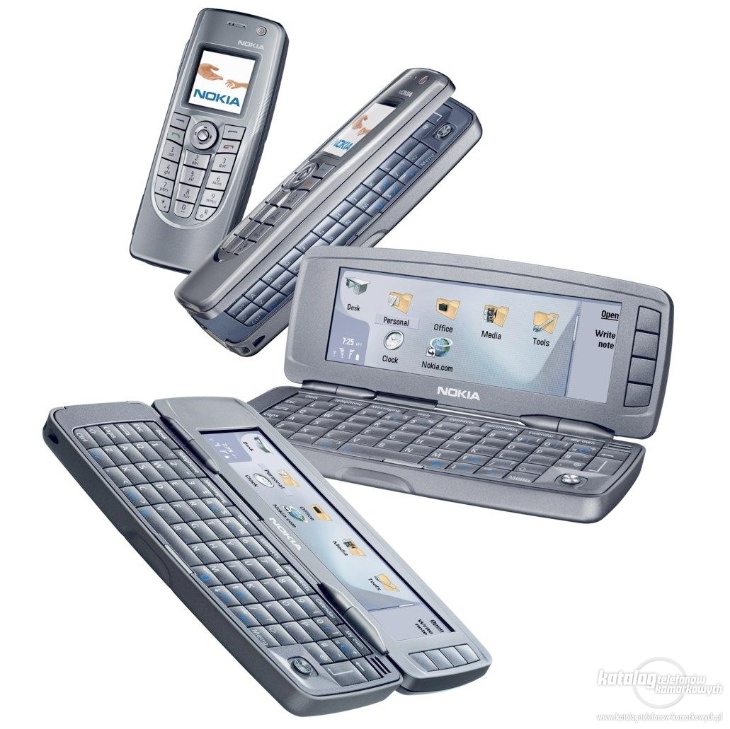
5. Nokia 9300
Ah yes, possibly my most controversial form factor choice here. The famous 'Communicator', identified very strongly with Nokia's iconic clamshell devices from 2000 to 2008. I've picked the 9300 here, but I could almost as well have picked the 9210 or 9500 or even the E90 - the idea's the same. Have a super-robust traditional 'phone' with conventional keys and operation, but then split the device down its thinnest side and open it like a clam - hence the term 'clamshell', to reveal a large landscape display on one half and a large qwerty keyboard on the other. Genius.
Nokia's product teams would point to the N97/N97 mini and the upcoming E7 as proof that similar large screen/qwerty hybrids are still very much in their thoughts, but it's not quite the same. When these later hybrids are closed, you've effectively got a touchscreen tablet, with all the usual disadvantages for real world use, i.e. needing delicate handling, needing two hands for many operations. With the classic Communicator form factor, you've got buttons and a one-handed interface, perfect for busy, active people, but with the full laptop-like qwerty form available when there's time to sit down and open up.
Even the E90 is now quite out of date in terms of its software, the 9300 and 9500 are positively archaic, using the older (very Psion-like) Series 80 menu-driven interface, but there's no reason why the E7's software couldn't be implemented for the 'inside' of a new Comminicator, at nHD resolution, with a cut down version for the external screen (suggest running at 320 by 360 showing just the top half of each homescreen, with actual apps using this reduced resolution and doing their usual good job of scaling the interface).
Nomenclature? It would be a Communicator, of course. Possibly the E95, indicating its heritage?
____________
Are there any other form factors from the Symbian world that you'd like to see revived? Nokia (or others), if you're reading this, please take heart that you were on the right track with these ideas and (in my opinion, at least) they're well worth re-exploring.
Steve Litchfield, AAS, 11 Dec 2010

